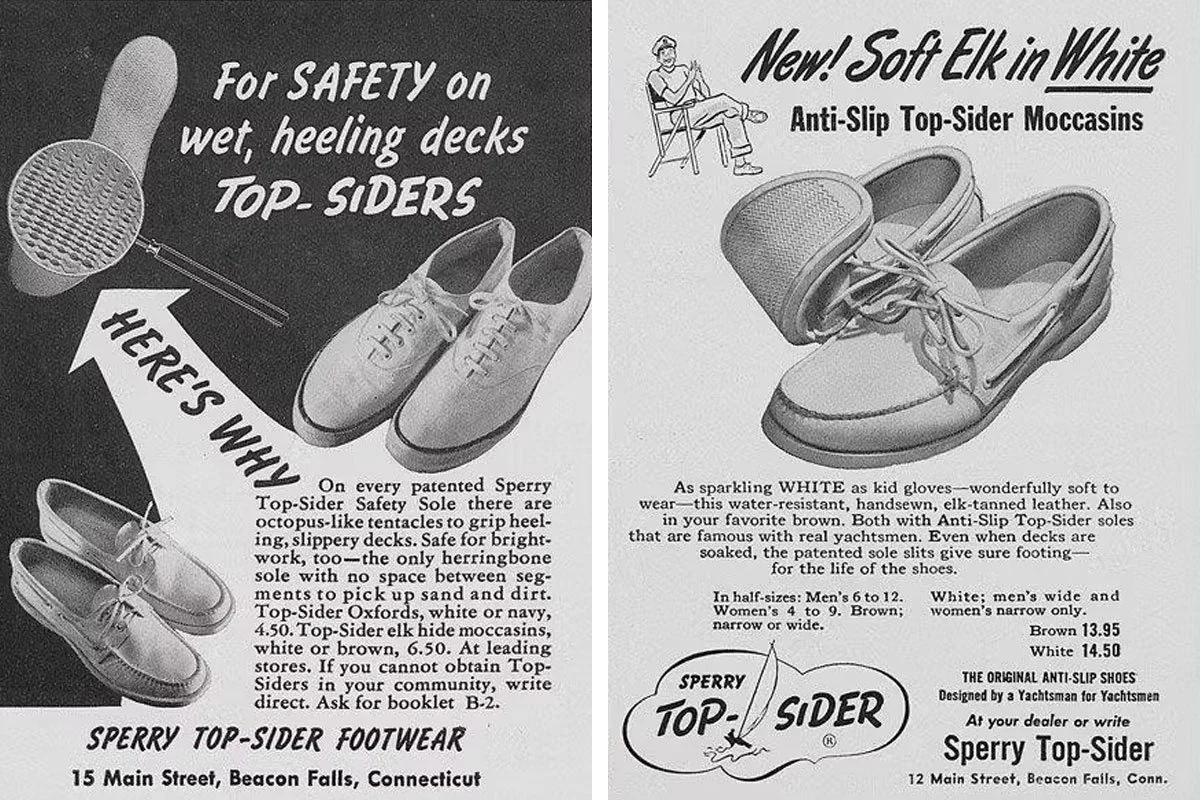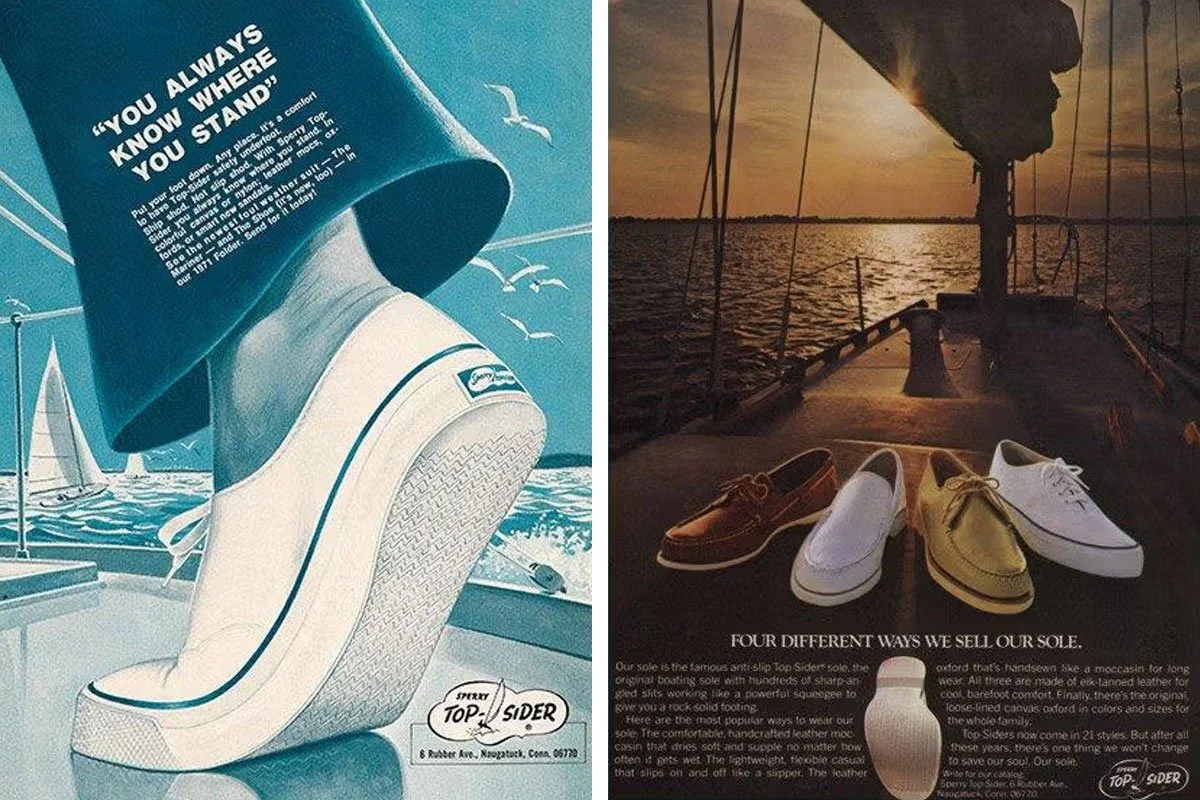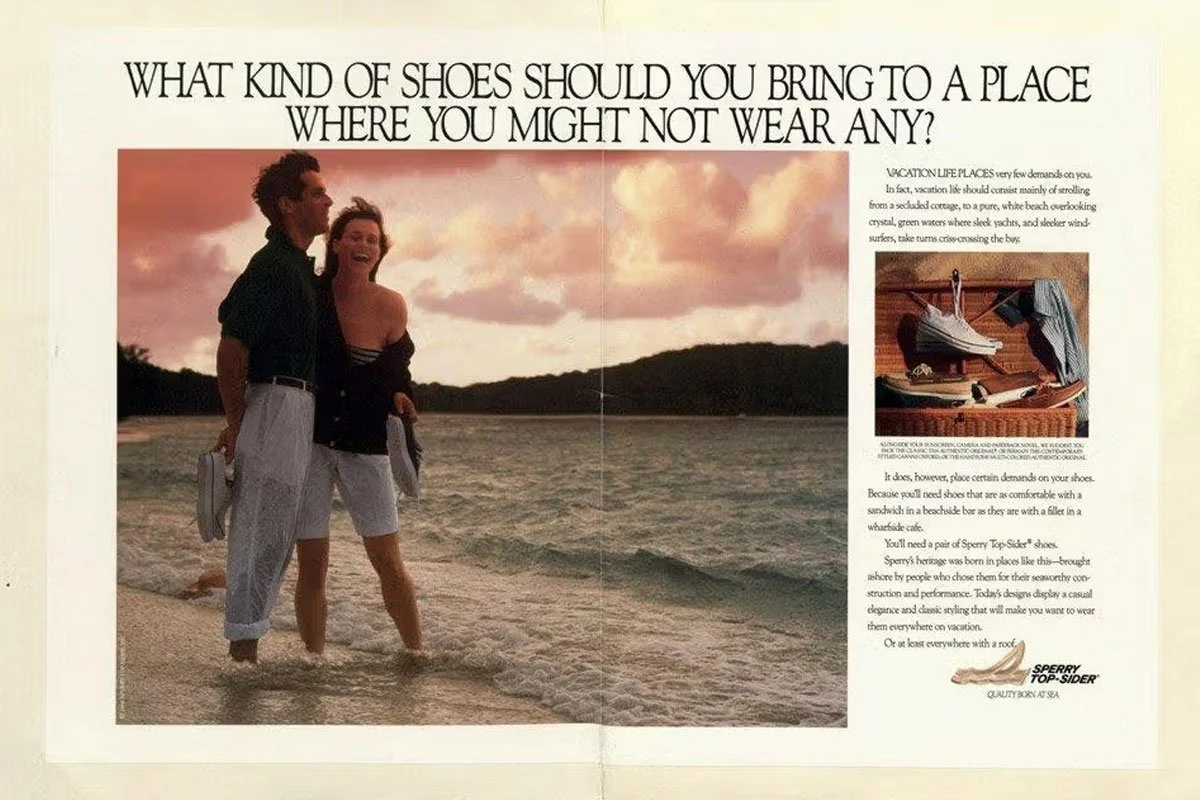The History of the Boat Shoe
Boat shoes are one of those shoes you immediately associate with summer. When they hear "boat shoe," most people think of a brown leather moccasin with laces and a white rubber sole. Some also call them deck shoes, which I consider something completely different - a canvas CVO (Circular Vamp Oxford). And even though these two styles look quite different, they’re actually pretty similar, as both were designed to prevent slipping on the deck of a boat. Today, that might sound like no big deal, but almost 100 years ago, it was a revolutionary invention by Paul Sperry with a little help from his beloved dog, Prince.
Sperry advertisement from 1990
Paul Sperry was born in 1895 in New Haven, Connecticut, where he developed a strong love for the outdoors and the sea. He preferred hunting, skiing, and sailing over time in the classroom. After finishing school he joined the Naval Reserve in 1917, gaining valuable maritime experience and discipline. When he returned, he began working as a salesman at his father Sereno’s company, the Pond Lily Company, which specialized in processing textiles. Around the same time, he founded Sperry Natural Decoys, combining his outdoor passion with his business skills.
In 1925 he married Pauline, who was also from New Haven. For their honeymoon, they went duck hunting in the cold at Chesapeake Bay, which shows just how much Paul loved the outdoors. In the 1930s, he bought a schooner named Sirocco, continuing his family’s connection to sailing. He and Pauline loved life on the water, joined sailing clubs, and spent much of their time sailing along the coast.
Paul Sperry with his invention.
One night on Long Island Sound, Paul Sperry slipped and fell off his boat, the Sirocco. Everyone was asleep, but he managed to grab some rigging and pull himself back on board. That experience stayed with him. When asked why he created the non-slip boat shoe, he said it was because he had fallen overboard.
At the time, boat shoes were either made with canvas and crepe rubber soles or had coiled rope soles. Crepe was slippery on wet decks, and rope soles were slippery when dry. Motivated by his accident, Paul spent the winter of 1935 in a workshop at his New Haven home, testing different rubber combinations to find a better solution. One snowy day, while walking his Cocker Spaniel Prince, he noticed how easily the dog ran on the icy surface. He thought it had something to do with the pads on Prince’s paws. When he looked closer, he saw that the natural cracks and grooves on the dog’s paws formed a pattern like herringbone, which helped him grip the ice.
This gave him the idea to cut fine, parallel grooves into the soles of his boating shoes. The rubber gripped well when pressure was applied at a right angle to the cuts but slipped when pressure was in the same direction as the cuts. Paul then tried a zig-zag pattern, now called siping and it worked. He glued the rubber to an old pair of shoes, creating the first Sperry Top-Sider prototype.
Sperry advertisement from 1941 and 1947
After testing his new design on the Sirocco, Paul confirmed that it prevented slipping. He filed for a patent and tried to bring the product to market, but the United States Rubber Company refused to produce it, saying the complex design would make the shoes cost $4.50, while the most expensive tennis shoes at the time were only $3.75. Not giving up, Paul made a deal with a rubber company in Boston to make blank soles. He then added the siping himself using a machine he created.
The first model, the Canvas Circular Vamp Oxford (CVO), came with a simple design with a cotton-lined upper and vulcanized rubber sole, making it stable and comfortable. But his black rubber-soled shoes had a design flaw – they left unsightly marks on the boat’s deck. He then tested other options and quickly found that white-soled shoes didn’t leave any marks. In the beginning Paul sold the shoes through direct mail, sending letters to yacht club members, which resulted in many orders. He also received a large order from his friend Frank Howard at Abercrombie & Fitch, and thanks to their widespread retail network, the Sperry Top-Sider quickly became popular across the United States.
Sperry advertisement from 1971 and 1975
After the success of the Canvas CVO, Paul wanted to create a sturdier leather version of his non-slip shoe. Between 1935 and 1937 he developed the Top-Sider, or Authentic Original (AO), a new design with moccasin toe stitching and saddle lacing, where the laces wrap around the ankle. He also invented a new way of tanning leather to resist salt and water, making the AO more durable. The AO was quickly adopted by Sperry’s retail network and became a success.
In 1939 during World War II, the US War Department made Sperry the official shoe of the Navy. Even Navy pilots wore them, and it’s said that John F. Kennedy wore Top-Siders during his time on the PT-109 in the South Pacific.
In 1941 Paul Sperry became president of the family’s other business Pond Lily, and decided to focus on it full-time, selling the patents for the Top-Sider to Uniroyal, while still staying involved in the business. Over the next two decades Uniroyal continued to sell Top-Siders, focusing on advertising in boating magazines, which kept the business moving forward.
Sperry advertisement from 1989
After the war boat shoes became more fashionable, especially popular among sailors in the Northeast and Great Lakes. In the 1960s they became a key element of preppy fashion, with John F. Kennedy Jr. often photographed wearing them. By the 1980s and 1990s boat shoes had become a mainstream trend on college campuses, usually in bright colors and paired with slouch socks and polo shirts, especially after being featured in The Official Preppy Handbook in 1980.
Almost 100 years later, boat shoes are still popular. Today you can find them in a variety of materials and colors. While traditional styles with leather uppers and rubber soles are considered classics, there are now many different versions - some more fashionable, others more minimal and elegant. You can choose whichever style you prefer, but can't deny that the boat shoe has become a classic silhouette and a symbol of timeless design.
I also made a list of the best quality boat shoes available today.
related articles









The Derby shoe we know today may have originally been designed as military footwear during the Napoleonic Wars. After nearly two centuries this shoe may not serve the same purpose as it once did, but it still plays a similar role in style.